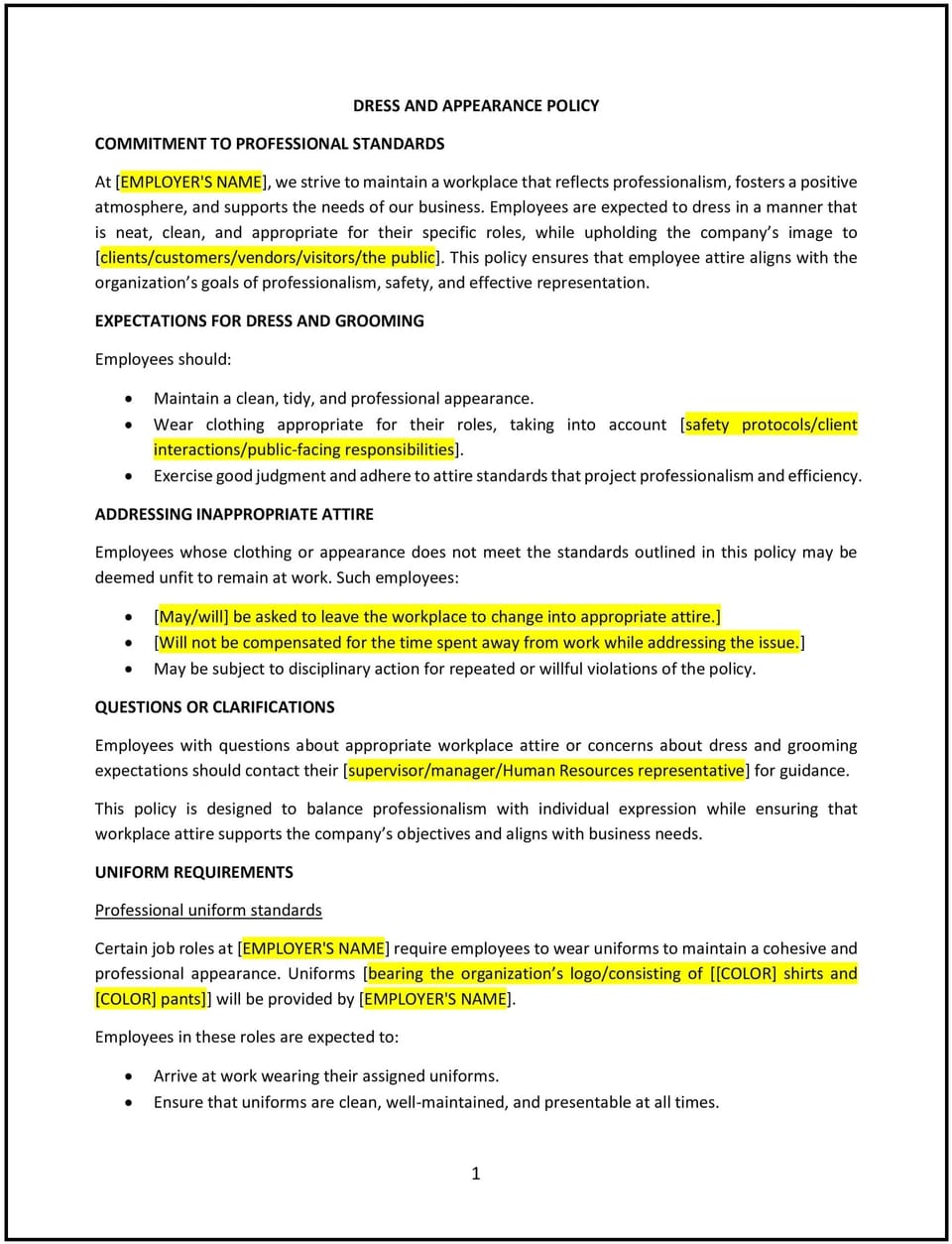Dress and appearance policy (New Hampshire): Free template

Dress and appearance policy (New Hampshire)
A dress and appearance policy helps New Hampshire businesses maintain a professional and respectful workplace environment by setting clear guidelines for employee attire and grooming. This policy outlines the expectations for how employees should dress in the workplace, ensuring that they reflect the company's image, uphold safety standards, and promote a positive work culture.
By adopting this policy, businesses in New Hampshire can foster a professional environment, create consistency in employee appearance, and ensure that dress codes align with the company’s values and industry standards.
How to use this dress and appearance policy (New Hampshire)
- Define acceptable attire: Outline the types of clothing that are appropriate for the workplace, specifying any uniforms, business casual attire, or specific dress requirements based on job roles and activities.
- Address grooming standards: Set expectations for employee grooming, including guidelines for hairstyles, facial hair, and personal hygiene.
- Identify exceptions: Specify any exceptions to the dress code, such as accommodations for religious attire, cultural expression, or health-related needs.
- Provide safety considerations: Include specific attire requirements for certain jobs or tasks that may involve safety hazards, such as protective clothing, footwear, or equipment.
- Encourage professional appearance: Emphasize the importance of dressing in a way that reflects the company’s image and values, and ensures employees are presentable and professional while interacting with clients, customers, and colleagues.
- Set consequences for non-compliance: Outline the consequences for failing to follow the dress and appearance policy, such as verbal warnings, disciplinary actions, or other corrective measures.
- Review and update: Regularly review the policy to reflect New Hampshire regulations, changes in industry standards, and evolving business needs.
Benefits of using this dress and appearance policy (New Hampshire)
This policy provides several benefits for New Hampshire businesses:
- Promotes a professional image: A clear dress and appearance policy helps create a consistent, professional image that aligns with the company’s values and promotes confidence in both employees and customers.
- Enhances employee morale: When employees understand the expectations around dress and appearance, it can contribute to a positive and respectful work environment.
- Increases safety: For roles that involve physical work or safety hazards, specifying appropriate attire can help prevent accidents and ensure a safe work environment.
- Supports inclusivity: By outlining exceptions for religious, cultural, or health-related attire, businesses can ensure that their policy is inclusive and respects employee diversity.
- Reduces confusion: Clear guidelines on dress and appearance eliminate confusion about what is considered appropriate, helping employees focus on their work.
Tips for using this dress and appearance policy (New Hampshire)
- Communicate the policy clearly: Ensure that all employees are aware of the dress and appearance policy, including specific expectations for attire, grooming, and safety.
- Provide flexibility: Allow for flexibility in the policy to accommodate diverse employee needs, including religious, cultural, or disability-related considerations.
- Be consistent: Apply the policy consistently across all employees, ensuring fairness and avoiding any appearance of discrimination.
- Review the policy regularly: Regularly review the policy to ensure that it aligns with industry trends, New Hampshire regulations, and employee feedback.
- Lead by example: Encourage leadership and managers to model the dress and appearance standards expected of employees, reinforcing the policy through actions.
Q: Why should New Hampshire businesses have a dress and appearance policy?
A: Businesses should implement a dress and appearance policy to maintain a professional image, promote safety, and create a respectful and inclusive workplace that aligns with company values.
Q: What types of clothing are considered appropriate for the workplace?
A: Businesses should specify the types of attire deemed appropriate for their specific workplace, such as business casual, uniforms, or professional attire, depending on the nature of the work.
Q: Can employees wear religious or cultural attire?
A: Yes, businesses should specify exceptions to the dress code to accommodate religious or cultural attire, ensuring that all employees feel respected and included.
Q: What if an employee’s clothing violates the dress code?
A: Businesses should outline the consequences for non-compliance, such as a verbal warning, corrective actions, or disciplinary measures, and ensure that employees are informed of these consequences.
Q: How should businesses handle employee grooming and personal hygiene?
A: Businesses should establish clear expectations for grooming, such as maintaining clean and neat hair, facial hair, and overall personal hygiene, while also allowing for flexibility in line with company culture.
Q: Are there exceptions for safety-related dress codes?
A: Yes, businesses should include specific guidelines for safety-related attire in roles that involve physical work or hazardous materials, such as wearing protective clothing, gloves, or footwear.
Q: How often should businesses review their dress and appearance policy?
A: Businesses should review the policy annually or whenever there are changes in New Hampshire laws, industry standards, or company practices to ensure it remains effective and aligned with company needs.
This article contains general legal information and does not contain legal advice. Cobrief is not a law firm or a substitute for an attorney or law firm. The law is complex and changes often. For legal advice, please ask a lawyer.


